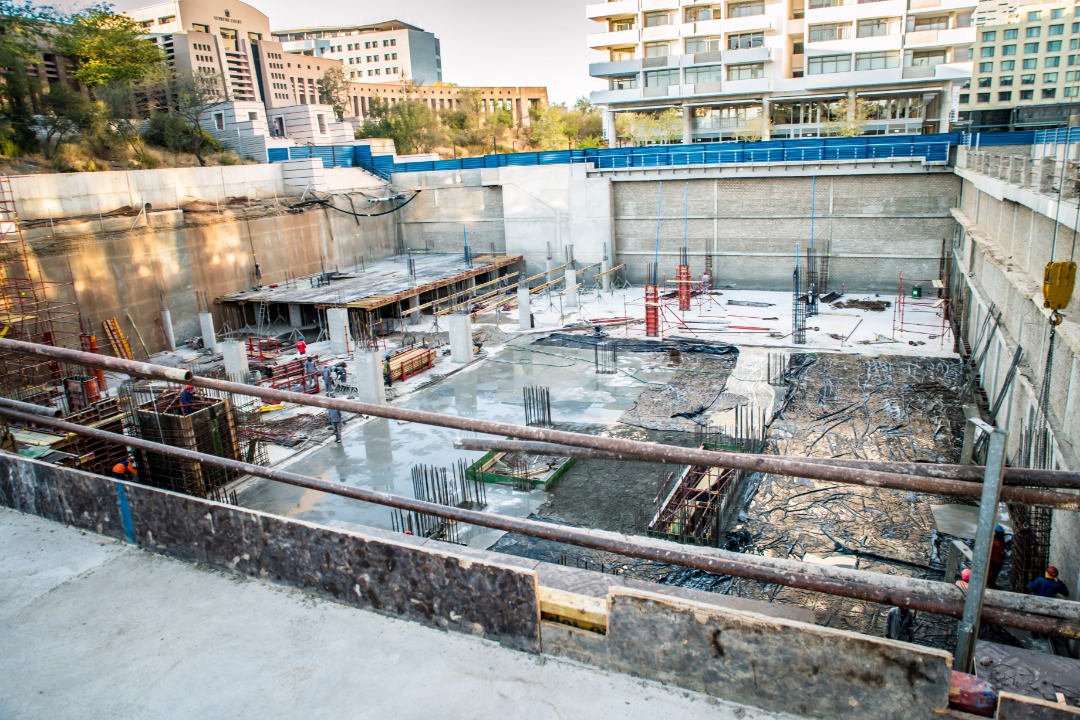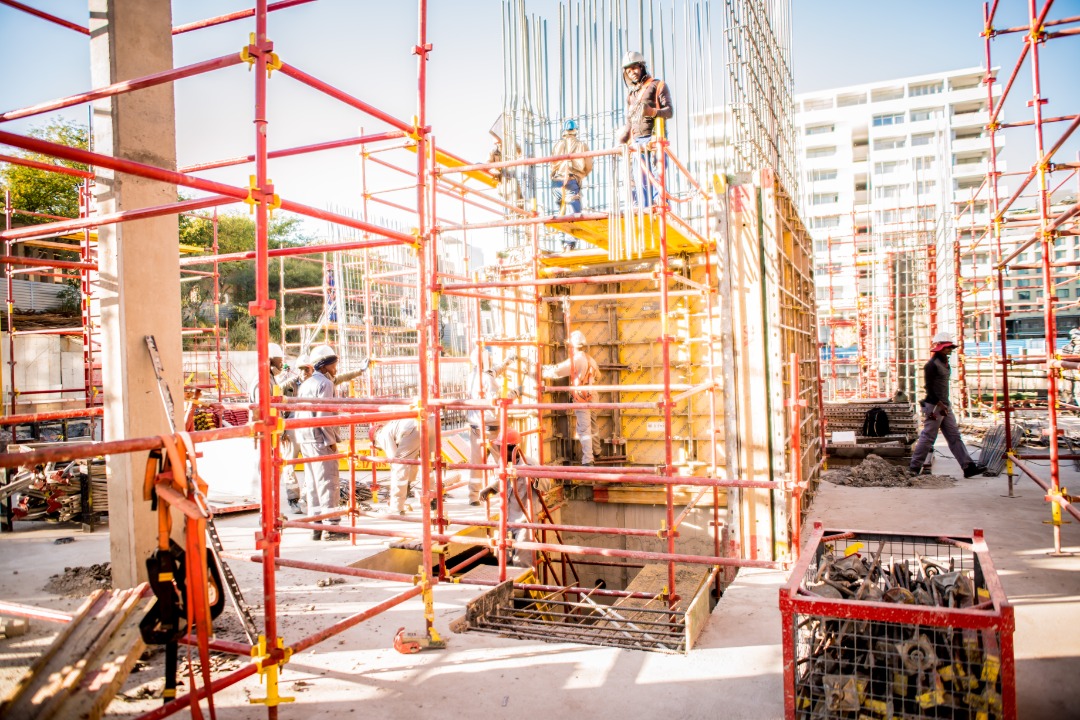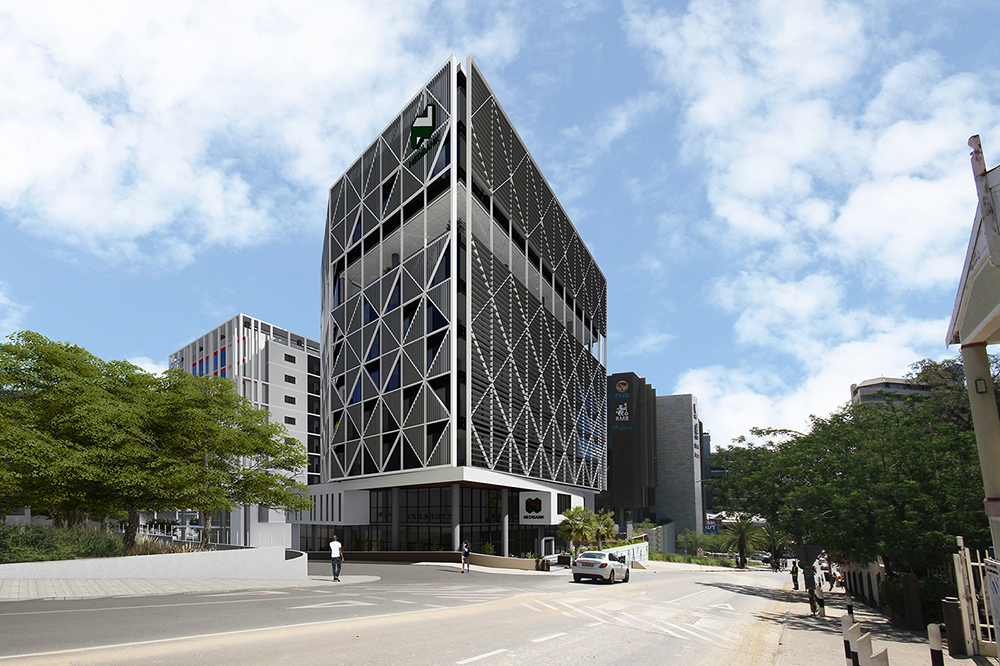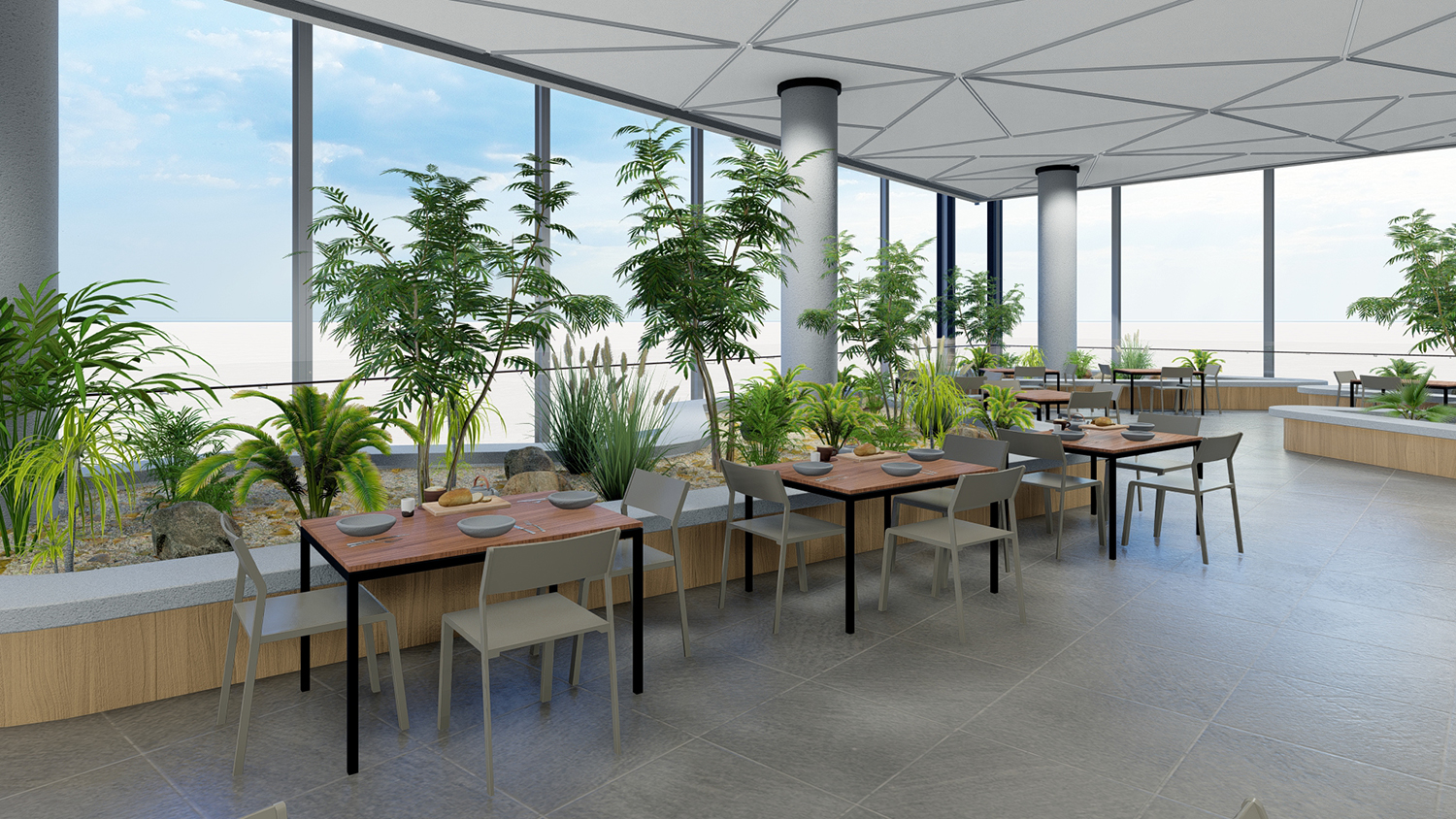Nedbank’s New Green Headquarters on Track
Smart design and innovative energy solutions are the pillars of Nedbank Namibia’s iconic new green headquarters being constructed in the central business district of Windhoek.
Pg 1+2 My.Na Properties
Staff Reporter
Throughout the world, architects and contractors are designing and building green skyscrapers. Green building is the practice of using resources such as energy, water, and materials in such a way as to reduce the impacts on both the environment and human health. Such buildings are good for the environment; they offer the occupants better health and productivity and are cost-efficient to operate.
The International Energy Agency (IEA) estimates that the use of energy for electricity and heating in buildings worldwide will double, if not triple, by 2050. And with the effects of climate change, the banking sector can play a vital role in accelerating the local market's transition to a lower carbon-energy future.
It is for that reason that for years Nedbank Namibia has been known as the “green bank”.
Cultivating a greener future
In 2001 Nedbank partnered with the Namibia Nature Foundation (NNF) and initiated the Go Green Fund. Since then, the Fund has granted millions of dollars to environmental projects ranging from the conservation of rare and endangered species to environmental education. The positive development impact of this relationship has delivered a spectacular track record for the private sector working in collaboration with civil society – bringing about change and contributing to Namibia's long-term development.
In its latest move as part of its trademark in supporting environmental projects, Nedbank’s construction of a new green headquarters located on Freedom Plaza in the city centre seemed a natural progression. At the groundbreaking ceremony in November 2018, former Windhoek Mayor Muesee Kazapua delivered the keynote address, applauding the bank for its continuous confidence in our economy.
The building, expected to be completed before the end of this year, delivers twenty two thousand square metres of basement and eight thousand square meters of office space, and represents close to half a billion Namibia Dollars in capital expenditure. This new environment-friendly project not only focuses on energy and water efficiency, but upholds the United Nations sustainability principles on the reconciliation of the natural, social and economic environments.
Therefore, the Green Building Council of South Africa, which has been key in driving the construction of green buildings on the continent, awarded the project a Five-Star design rating, with an overall score of 72 out of the targeted 74 points, only 3 points short of the maximum Six-Star rating.
Efficiency reimagined
Energy consumption, one of the most important aspects of the green rating system, requires intense focus on the quality of the indoor environment, including the amount of fresh air, external views, thermal comfort and noise output level. It is against this background that the performance levels of energy, waste and water will be regularly displayed to occupants and visitors at various points, to foster awareness. To benefit from Namibia’s overabundance of sunlight, the design also includes a solar panel roof structure.
With an eye to the future and Namibia’s scarcity of water, the design team incorporated innovative water-saving strategies, with harvesting of rainwater and greywater recycling. As part of the green features, a sky garden with endemic and drought-resistant plants will add a pleasing feeling to the building. All-in-all, over one thousand six hundred tons of reinforcing steel forms the backbone of the building, while the construction steel also consisted of 90% recycled metal.
Pewer Fourie, a member of EMCON Consulting Group, a local entity tasked to spearhead the project from start to finish, explained that the reasons for going green are multiple, and ultimately, crucial. “We have seen how employees and clients change their outlook and behaviours at work and at home as a result of working in a green building having moved from a conventional building into a green building ourselves. We are super proud to be part of this project and hope that may others will follow to contribute towards Namibia’s sustainability.”
For 12 months after occupation of the building, the professional team and contractors will fine-tune all systems to ensure they perform in accordance with the design. In addition, Nedbank has also begun a three-year programme to prepare staff and introduce sustainability practices into their existing buildings.
With this new development, Nedbank Namibia again strives of being ‘a great place to work, a great place to bank, and a great place to invest’.
Pg 1+2 My.Na Properties
Staff Reporter
Throughout the world, architects and contractors are designing and building green skyscrapers. Green building is the practice of using resources such as energy, water, and materials in such a way as to reduce the impacts on both the environment and human health. Such buildings are good for the environment; they offer the occupants better health and productivity and are cost-efficient to operate.
The International Energy Agency (IEA) estimates that the use of energy for electricity and heating in buildings worldwide will double, if not triple, by 2050. And with the effects of climate change, the banking sector can play a vital role in accelerating the local market's transition to a lower carbon-energy future.
It is for that reason that for years Nedbank Namibia has been known as the “green bank”.
Cultivating a greener future
In 2001 Nedbank partnered with the Namibia Nature Foundation (NNF) and initiated the Go Green Fund. Since then, the Fund has granted millions of dollars to environmental projects ranging from the conservation of rare and endangered species to environmental education. The positive development impact of this relationship has delivered a spectacular track record for the private sector working in collaboration with civil society – bringing about change and contributing to Namibia's long-term development.
In its latest move as part of its trademark in supporting environmental projects, Nedbank’s construction of a new green headquarters located on Freedom Plaza in the city centre seemed a natural progression. At the groundbreaking ceremony in November 2018, former Windhoek Mayor Muesee Kazapua delivered the keynote address, applauding the bank for its continuous confidence in our economy.
The building, expected to be completed before the end of this year, delivers twenty two thousand square metres of basement and eight thousand square meters of office space, and represents close to half a billion Namibia Dollars in capital expenditure. This new environment-friendly project not only focuses on energy and water efficiency, but upholds the United Nations sustainability principles on the reconciliation of the natural, social and economic environments.
Therefore, the Green Building Council of South Africa, which has been key in driving the construction of green buildings on the continent, awarded the project a Five-Star design rating, with an overall score of 72 out of the targeted 74 points, only 3 points short of the maximum Six-Star rating.
Efficiency reimagined
Energy consumption, one of the most important aspects of the green rating system, requires intense focus on the quality of the indoor environment, including the amount of fresh air, external views, thermal comfort and noise output level. It is against this background that the performance levels of energy, waste and water will be regularly displayed to occupants and visitors at various points, to foster awareness. To benefit from Namibia’s overabundance of sunlight, the design also includes a solar panel roof structure.
With an eye to the future and Namibia’s scarcity of water, the design team incorporated innovative water-saving strategies, with harvesting of rainwater and greywater recycling. As part of the green features, a sky garden with endemic and drought-resistant plants will add a pleasing feeling to the building. All-in-all, over one thousand six hundred tons of reinforcing steel forms the backbone of the building, while the construction steel also consisted of 90% recycled metal.
Pewer Fourie, a member of EMCON Consulting Group, a local entity tasked to spearhead the project from start to finish, explained that the reasons for going green are multiple, and ultimately, crucial. “We have seen how employees and clients change their outlook and behaviours at work and at home as a result of working in a green building having moved from a conventional building into a green building ourselves. We are super proud to be part of this project and hope that may others will follow to contribute towards Namibia’s sustainability.”
For 12 months after occupation of the building, the professional team and contractors will fine-tune all systems to ensure they perform in accordance with the design. In addition, Nedbank has also begun a three-year programme to prepare staff and introduce sustainability practices into their existing buildings.
With this new development, Nedbank Namibia again strives of being ‘a great place to work, a great place to bank, and a great place to invest’.









Comments
Namibian Sun
No comments have been left on this article